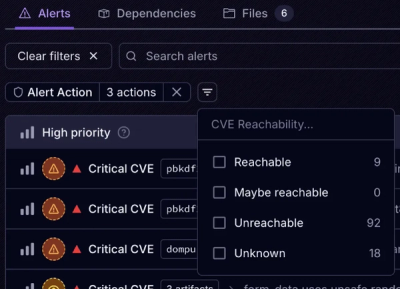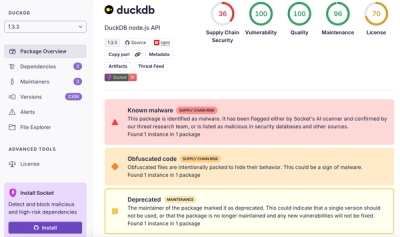
Product
Introducing Tier 1 Reachability: Precision CVE Triage for Enterprise Teams
Socket’s new Tier 1 Reachability filters out up to 80% of irrelevant CVEs, so security teams can focus on the vulnerabilities that matter.
github.com/johannesjo/angular-promise-buttons
Chilled Buttons for AngularJS
For Angular 2+ version go here.
There are cool loading buttons out there for angular. Only thing which annoys me, is that you (most of the times) have to manually trigger their loading state via a boolean which leads to a bit of repetition, declaring those again and again. angular-promise-buttons exists to take away some of that, by handling the loading state directly by passing the promise. Saves you at least two lines of code every time. Check out the DEMO!
Also you can play with the code on Plnkr.
Bug-reports or feature request as well as any other kind of feedback is highly welcome!
Install it via bower or npm
bower install angular-promise-buttons -S
# or via npm
npm install angular-promise-buttons -S
and add angularPromiseButtons as dependency in your main module:
angular.module('yourApp',[
'angularPromiseButtons'
]);
Using the buttons is easy. Just return the promise in question in your service caller and you're good to go:
You can also directly return the promise via the function passed to ng-click:
<button ng-click="yourServiceCaller()"
promise-btn>Click me to spin!</button>
// inside some controller
$scope.yourServiceCaller = function ()
{
return fakeFactory.method().then(...);
};
For using the promise buttons with ng-submit you need to apply them to the form directive and add `type="submit" to the buttons you want to show a loader for:
<form ng-submit="yourServiceCaller()"
promise-btn>
<button type="submit">MyBtn</button>
</form>
// inside some controller
$scope.yourServiceCaller = function ()
{
return fakeFactory.method().then(...);
};
There is also an alternative syntax, which allows you to share promises between buttons (and possibly other directives) and is especially useful, if you want to use the $event somehow:
<button ng-click="yourServiceCaller($event)"
promise-btn="yourPromise">MyBtn</button>
Now you just have to assign a promise to yourPromise:
// inside some controller
$scope.yourServiceCaller = function ()
{
$scope.yourPromise = fakeFactory.method().then(...);
// this is now also possible
$event.preventDefault();
};
The base-styles might not be overwhelmingly sexy, but it is easy to fix that! There are lots of free css-spinners out there. Just find one of your liking and add the css.
Ressources:
There are also some defaults for you to set, if you like. You can do this by using the angularPromiseButtonsProvider:
angular.module('exampleApp', [
'angularPromiseButtons'
])
.config(function (angularPromiseButtonsProvider)
{
angularPromiseButtonsProvider.extendConfig({
spinnerTpl: '<span class="btn-spinner"></span>',
disableBtn: true,
btnLoadingClass: 'is-loading',
addClassToCurrentBtnOnly: false,
disableCurrentBtnOnly: false,
minDuration: false,
CLICK_EVENT: 'click',
CLICK_ATTR: 'ngClick',
SUBMIT_EVENT: 'submit',
SUBMIT_ATTR: 'ngSubmit',
BTN_SELECTOR: 'button'
});
});
promise-btn-optionsYou can also change all the options (but not the spinner template) by specifying the options via promise-btn-options:
<button class="btn"
ng-click="yourServiceCaller()"
promise-btn-options="options"
promise-btn="yourPromise">MyBtn <span>Look I'm nested content</span>
</button>
Now you just have to assign a promise to yourPromise:
// inside some controller
$scope.options = {
disableBtn: false,
btnLoadingClass: 'is-spinning'
};
$scope.yourServiceCaller = function ()
{
$scope.yourPromise = fakeFactory.method().then(...);
};
Thats all the logic there is (for now). Adjusting the look and feel of the spinner can be done using your own styles.
I'm happy for any issue or feature request, you might encounter or want to have. Even a one liner is better, than no feedback at all. Pull requests are also highly welcome. Just fork the repository, clone it and run grunt serve for development. Another important factor is the number of developers using and thus testing angular-promise-buttons. Tell your fellow programmers, say that you use it on ng-modules, tweet or even blog about it.
angular-promise-buttons is published under the The GNU Lesser General Public License V2.1.
FAQs
Did you know?

Socket for GitHub automatically highlights issues in each pull request and monitors the health of all your open source dependencies. Discover the contents of your packages and block harmful activity before you install or update your dependencies.

Product
Socket’s new Tier 1 Reachability filters out up to 80% of irrelevant CVEs, so security teams can focus on the vulnerabilities that matter.

Research
/Security News
Ongoing npm supply chain attack spreads to DuckDB: multiple packages compromised with the same wallet-drainer malware.

Security News
The MCP Steering Committee has launched the official MCP Registry in preview, a central hub for discovering and publishing MCP servers.